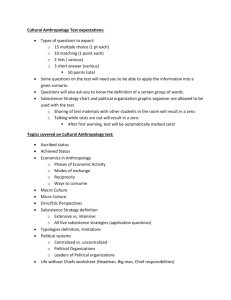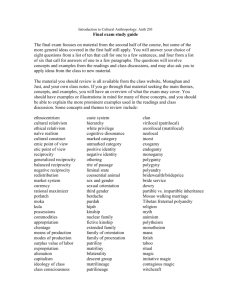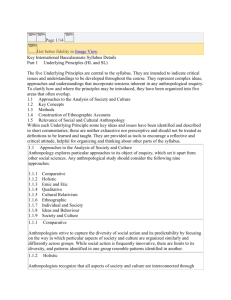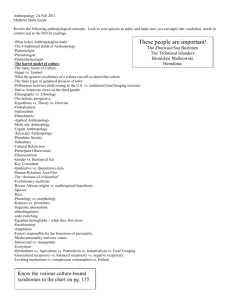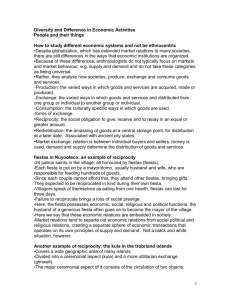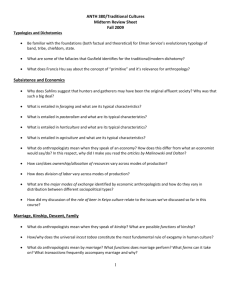Study guide for the midterm exam
advertisement
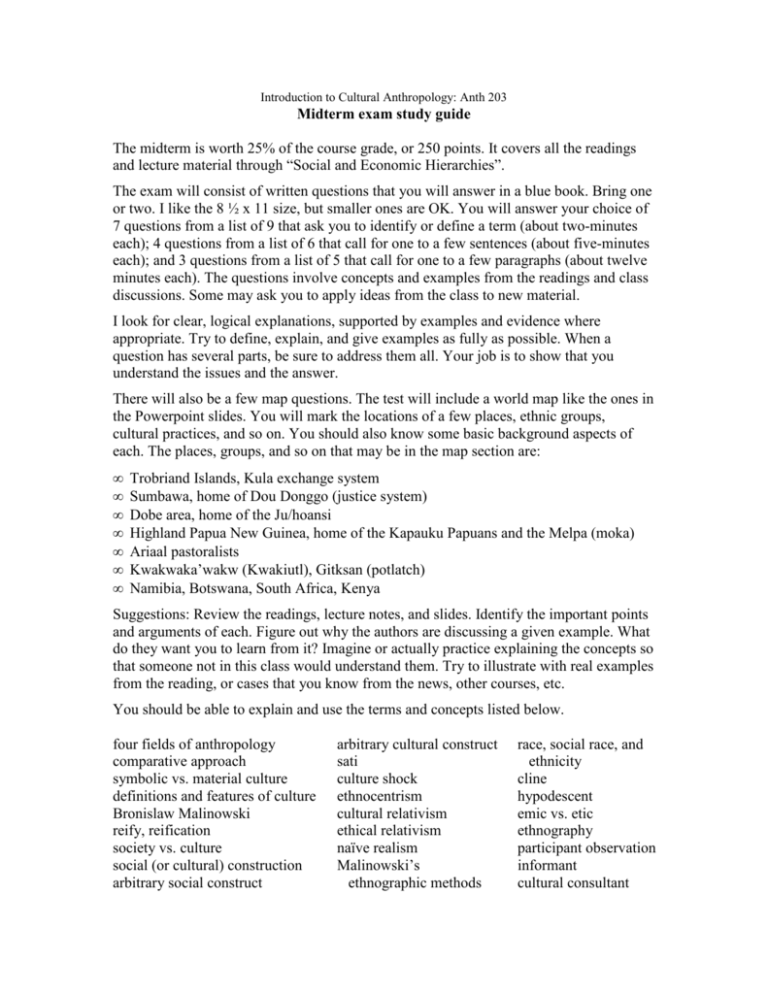
Introduction to Cultural Anthropology: Anth 203 Midterm exam study guide The midterm is worth 25% of the course grade, or 250 points. It covers all the readings and lecture material through “Social and Economic Hierarchies”. The exam will consist of written questions that you will answer in a blue book. Bring one or two. I like the 8 ½ x 11 size, but smaller ones are OK. You will answer your choice of 7 questions from a list of 9 that ask you to identify or define a term (about two-minutes each); 4 questions from a list of 6 that call for one to a few sentences (about five-minutes each); and 3 questions from a list of 5 that call for one to a few paragraphs (about twelve minutes each). The questions involve concepts and examples from the readings and class discussions. Some may ask you to apply ideas from the class to new material. I look for clear, logical explanations, supported by examples and evidence where appropriate. Try to define, explain, and give examples as fully as possible. When a question has several parts, be sure to address them all. Your job is to show that you understand the issues and the answer. There will also be a few map questions. The test will include a world map like the ones in the Powerpoint slides. You will mark the locations of a few places, ethnic groups, cultural practices, and so on. You should also know some basic background aspects of each. The places, groups, and so on that may be in the map section are: • • • • • • • Trobriand Islands, Kula exchange system Sumbawa, home of Dou Donggo (justice system) Dobe area, home of the Ju/hoansi Highland Papua New Guinea, home of the Kapauku Papuans and the Melpa (moka) Ariaal pastoralists Kwakwaka’wakw (Kwakiutl), Gitksan (potlatch) Namibia, Botswana, South Africa, Kenya Suggestions: Review the readings, lecture notes, and slides. Identify the important points and arguments of each. Figure out why the authors are discussing a given example. What do they want you to learn from it? Imagine or actually practice explaining the concepts so that someone not in this class would understand them. Try to illustrate with real examples from the reading, or cases that you know from the news, other courses, etc. You should be able to explain and use the terms and concepts listed below. four fields of anthropology comparative approach symbolic vs. material culture definitions and features of culture Bronislaw Malinowski reify, reification society vs. culture social (or cultural) construction arbitrary social construct arbitrary cultural construct sati culture shock ethnocentrism cultural relativism ethical relativism naïve realism Malinowski’s ethnographic methods race, social race, and ethnicity cline hypodescent emic vs. etic ethnography participant observation informant cultural consultant genealogical method interview schedule life history longitudinal study ethnographic present reflexive ethnography real vs. ideal culture cultural materialism infrastructure vs. structure vs. superstructure Marvin Harris culture as text Clifford Geertz subsistence hunting and gathering foraging agriculture swidden • • • • • • • • • • • • • • • • • • • • • slash and burn shifting agriculture fallow intensification pastoralism agropastoralism sedentary/sedentism semi-sedentary nomadic transhumant agropastoralism subsistence agriculture cash cropping wage labor system classical capitalist market theory rational maximizer utility Market system currency wealth Redistributive system Reciprocity generalized reciprocity balanced reciprocity negative reciprocity Kula exchange system client vs. patron possession vs. commodity alienation and appropriation of commodities hxaro exchange hierarchy caste system Things we can learn from culture shock Evidence that culture's effect on perception, thought, and behavior is profound Problems with race as a biological concept Evidence that race is a cultural construct Reasons why race appears to be a biological reality even though we know it is not Ethical issues raised by cultural relativism, including some examples Anthropological research methods, and some benefits of using them Genealogical notation: be able to read, draw, and use genealogical charts to explain aspects of social interactions Some critiques or problems with the ethnographic method, and responses to them Why anthropologists often focus on issues that make people uncomfortable, seem cynical, or seem to emphasize hypocrisy Culture as adaptation, meaning, and system (Middleton) Cultural materialism and the examples in the reading about Marvin Harris Culture as text, and the examples in the reading about it General subsistence practices of foragers (illustrated by the Ju/’hoansi), farmers (illustrated by the Kapauku Papuans), and pastoralists (illustrated by the Ariaal) Issues with the notion of “progress” Lee's evidence and arguments concerning foraging: diet, health, amount of work, etc. Issues and explanations concerning the transition from foraging to farming Ways in which subsistence strategies are interconnected with other aspects of society How economic exchange is embedded in social relations, and some examples such as the Kula ring, potlatch, moka, and Christmas gift exchange in our society Integrative vs. exploitative theories of social stratification Marxian model of economics and social stratification: means of production, surplus value of labor, expropriation, alienation, repression, ideology of class, class consciousness Anth 203 S 2010 midterm exam study guide p. 3 Typical two-minute ID questions: What is participant observation? What is hypodescent? Typical five-minute short answer questions: List and briefly explain five characteristics of culture discussed in class. What are infrastructure, structure, and superstructure, and how are they related in the cultural materialist way of thinking? Explain the three general kinds of reciprocity, and give an example of each. Typical twelve-minute longer questions: Explain why anthropologists say that races, as the term is commonly used, do not exist among humans. Why does it appear that that there are several races of humans? The same anthropologists will say that “race matters”. Explain. In many societies, a husband is expected to have a tense relationship with his mother-inlaw (his wife’s mother). Draw and label a kinship chart using standard notation that shows two hypothetical families joined by a marriage, identify the husband, and identify the person with whom he has this tense relationship. Explain the Hindu prohibition on eating beef in terms of meaning. Is this an emic or an etic explanation? Explain. Provide another explanation in cultural materialist terms. Is this second explanation an example of culture as adaptation, meaning, or system? Explain. Is it emic, or etic? Explain. Typical one-minute map questions (accompanied by a world map): Mark and label the location of the Trobriand Islands. Mark and label where the Ju/’hoansi lived when Lee wrote his ethnography. Mark and label where potlatches were practiced.
